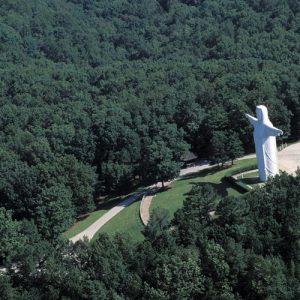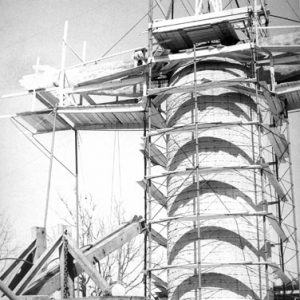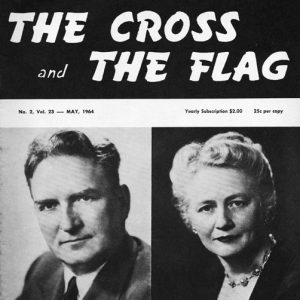calsfoundation@cals.org
Christ of the Ozarks
Christ of the Ozarks is a statue located in Eureka Springs (Carroll County) on top of Magnetic Mountain. The white mortar figure of Jesus Christ is seven stories tall and weighs almost two million pounds (about 540 tons). The statue is one of five giant statues of Christ in the world and one of only two in North America. It was sculpted by Emmet A. Sullivan and funded by the Elna M. Smith Foundation.
The Elna M. Smith Foundation was founded in 1965 as a non-profit organization named for, and headed by, the wife of Gerald L. K. Smith, who gained prominence as an anti-Semitic minister and political agitator in the 1930s. At a reported cost of $5,000, the foundation purchased 167 acres of land atop Magnetic Mountain, seven of which are within Eureka Springs city limits. Although the total cost of the project was never revealed, it exceeded three times the estimated cost, according to Gerald Smith. The site, which serves as the burial place of the Smiths, is also the location of the Great Passion Play, Bible Museum, Sacred Arts Center, and New Holy Land—collectively known as the “Sacred Projects.” Gerald Smith claimed the Sacred Projects were supposed to set the historical record straight, which contained nothing that would “flatter the Christ hating Jews.”
Standing on a foundation of 320 tons of concrete with reinforcing steel, the statue was built to withstand winds of 500 miles an hour and has a two-foot rectangle in the top of the head for pressure equalization in case of a passing tornado. The face itself is fifteen feet long. The arms, with a spread of sixty-five feet from fingertip to fingertip, suggest the crucifixion. The representation of Christ was built completely by hand, constructed of twenty-four layers of white mortar interlaced with a steel frame. The robes and hair were sculpted by workmen on scaffolds who built an elevator so that they could reach the higher segments of the statue. The statue was dedicated on Saturday, June 25, 1966, although the folds of the robe took an additional three weeks to complete.
Visible from a distance of twenty miles, the silhouette of Christ of the Ozarks appears to be a large, white cross. Although Smith likened it to the famous works of Michelangelo, many people have severely criticized the statue, saying that it looks like a “Gumby Christ” or a milk carton with a tennis ball on top. The statue continues to be a major source of conflict in and outside of Eureka Springs.
Christ of the Ozarks and the nearby Passion Play are located near the intersection of U.S. Highway 62 and Arkansas State Highway 23. In 2016, a $20,000 renovation of the statue began.
For additional information:
Bowden, Bill. “Christ of the Ozarks Statue Turns 50.” Arkansas Democrat-Gazette, August 21, 2016, pp. 1A, 10A.
Branam, Chris. “After 40 Years, Christ of Ozarks Statue Still Beckons.” Arkansas Democrat-Gazette, June 4, 2006, pp. 1B, 7B.
Davis-Baltz, Sandy. “The Making of a Monument: Social Implications of Arkansas Case Studies.” PhD diss., Arkansas State University, 2005.
Grubiak, Margaret M. Monumental Jesus: Landscapes of Faith and Doubt in Modern America. Charlottesville: University of Virginia Press, 2020.
Lewis, Bill. “Smith’s Statue Is Dedicated As Mayor Opposes Bigotry.” Arkansas Gazette, June 26, 1966, p. 1A.
“Smith Foundation’s Christ of Ozarks Is Finished, Dedication Is Saturday.” Arkansas Gazette, June 22, 1966, p. 1A.
Starr, Norma. “Eureka Springs: New Charms and Old.” Arkansas Democrat Sunday Magazine, July 28, 1968, pp. 6–7.
Elizabeth Hennelly
Roland, Arkansas
 Religion
Religion Tourism
Tourism Christ of the Ozarks
Christ of the Ozarks  Christ of the Ozarks
Christ of the Ozarks  Christ of the Ozarks
Christ of the Ozarks  The Cross and the Flag
The Cross and the Flag 



Comments
No comments on this entry yet.